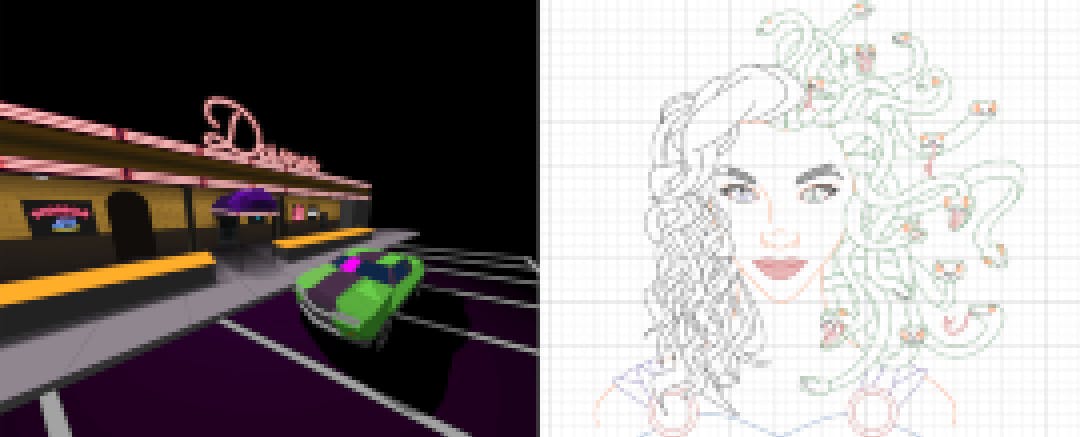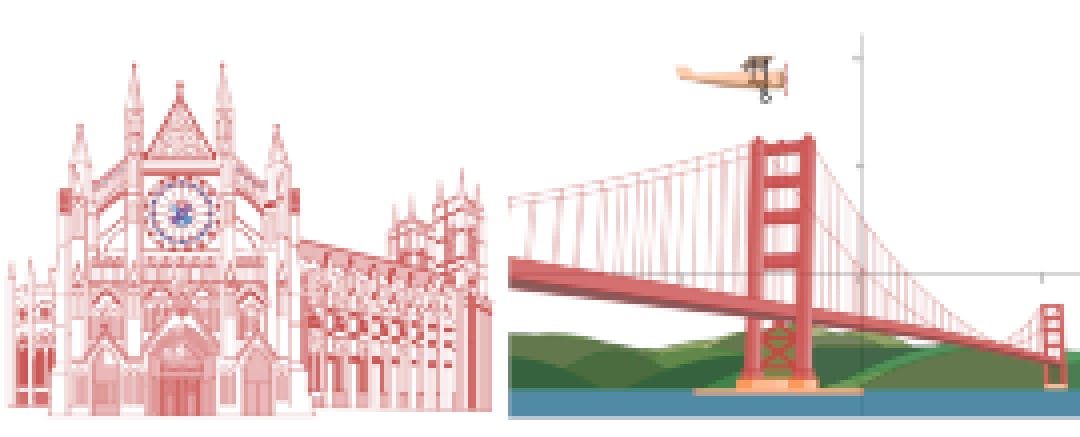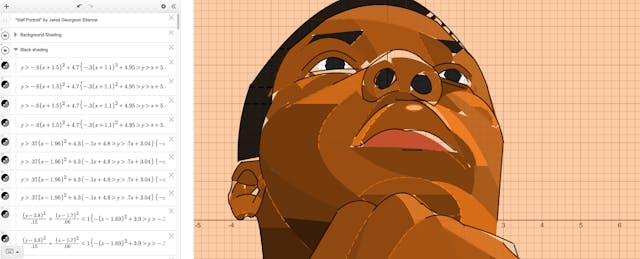It’s an art competition unlike most others. Contestants must use a graphing calculator and “draw” every line, curve, shade and highlight with an equation.
One entry looks like an animation straight from a video game. Another is a recreation of Vincent Van Gogh’s famous “Starry Night.” Others could pass for postcards of the iconic Hong Kong skyline or the Eiffel Tower.
But these aren’t professional animators or graphic artists. Try high school students.
“It’s been impressive to see students create true masterpieces,” says Suzanne von Oy, a graphing specialist at Desmos, the company that organized the contest.
Announced on March 6, the competition challenged students to create any artwork of their choice using the company’s online graphing calculator. The rules were simple enough. But what students submitted were anything but.
“Looking at these projects, it’s clear that some kids have been so motivated to make beautiful graphs that they’re going out to learn math that most kids don’t learn until college,” says von Oy. “We see 13, 14-year-olds going online and asking their peers to learn about things that are beyond what they’d normally learn in class.”
For instance, the “Starry Night” recreation was done using Bézier curves, a technique often used in computer graphics. Another student used Python to program Fourier Transform functions to animate a flower. These aren’t concepts found in most high-school math textbooks. “It’s wildly outside what most students get exposed to in school,” says von Oy.

Grace Kanaley, a sophomore at Huntington Beach High School in southern California, submitted a drawing of Medusa, inspired by her interest in Greek mythology and math. Graphing the wavy curves of the hair and snakes was itself a learning curve. Kanaley said she taught herself new trigonomic functions to rotate parabolas and make ovals for the drawing. She estimated she spent about five hours every day for a month to finish.
Kanaley also wanted to use the competition to pose a challenge of her own. Her submission, titled, “Victim Turned Villain,” is intended to “be a teaching moment,” she says. While usually associated with frightening snakes, “Medusa is a complex character, and I wanted to show that you shouldn’t judge people by preconceived notions or by the single story you hear.”
In less than two months, Desmos received submissions from more than 4,000 students from over 100 countries and territories. The team selected 60 finalists across three age groups (13-14, 15-16, 17-18) in May, and yesterday announced the winners and runner-ups in each age group. All are getting cash prizes, up to $500.
Narrowing the field was “amazingly difficult,” says Eli Luberoff, CEO and co-founder of Desmos. There was one rule that helped winnow it down: Submissions couldn’t include recognizably copyrighted material. “We got some Disney characters,” he shares, which were disqualified. The others were evaluated based on visual details and creative use of math formulas and animation features.
Desmos is no stranger to beautiful doodles. Since it launched in 2011, the company’s online graphing calculator has been used to create everything from Valentine’s Day “Math-o-grams” to Picasso paintings. It boasts a growing fanbase of students who share their artwork and tips for creating them in online forums on Discord and Reddit.
“We believe that the line between math, arts and humanities is a lot blurrier than what most people make it out to be,” says Luberoff. “Math isn’t just the regurgitation of formulas. It can be about expression and creativity, and we want to give students every opportunity to create things using math.”
Mashing the arts and math is core to Desmo’s belief that education is interdisciplinary by nature, and subjects should be taught as such. It challenges prevailing assumptions that some people pick up “hard” skills in math and science more naturally. Or that others are more “right-brain dominant” and thus more suited to creative careers.
If the Desmos team had its way, no one—student or adult—would have a reason to say: “I’m just not a math person.”

From Calculator to Curriculum
Just as it is trying to break down the artificial divide between arts and mathematics, Desmos is also aiming to break outside its own box of sorts.
The company remains best known for its interactive graphing tool that works on popular web browsers and devices. That effort was fueled partly by a belief that no student should have to fork out $100 for a physical graphing calculator ever again. Luberoff has been vocal about wanting to give companies like Texas Instruments, the biggest producer of such tools, a run for their money in this market.
While Texas Instrument is still around, Desmos has found a profitable business model. The company licenses its calculator to publishers and other edtech developers for use in their software. Luberoff says that end-of-year assessments in 35 U.S. states, as well as the ACT, SAT and International Baccalaureate exams, now rely on its technology to power its online graphing tools.
As a result, tens of million students and teachers across the world have used Desmos, according to Luberoff.
But the company has long harbored grander aspirations than being a snazzy calculator.
“While we’re extremely proud of the impact that we’ve had as a calculator, we know that a tool is only as good as the context in which it’s used. It’s been our desire for a while to go deeper to engage with students in classrooms,” says Luberoff.
Over the years, the company created accompanying lessons for teachers and students to use on its calculator technology. The activities are a departure from what one might otherwise expect in a math lesson; they include writing stories, manipulating images and solving puzzles. Students interact with digital kaleidoscopes, marbles and racing turtles. One eventually encounters variables, formulas and equations, but they are not front and center of the lesson.
Lee Anne Nugent, the geometry and precalculus teacher at Villa Walsh Academy, an all-girls’ private school in Morristown, N.J., discovered Desmos last year. She’s used it to create her own art challenges, such as tasking students to graph a snowman. And two of her students were finalists in the company’s art contest (their submissions are below).
Nugent says the versatility of the tool, and the open-endedness of the exercises, has helped engage students who otherwise didn’t think they liked math. “It ties different math concepts together and makes it concrete for them. It’s not just rote learning.”
And, she adds, “for a geeky math person like me, it’s fun.”

In 2018, Desmos decided to set its sights on a big, new and highly contested market: creating a core math curriculum, starting with middle school.
“The impact that we want to have on students’ education wasn’t possible with the supplementary activities we created, slotted in among other curriculums that teachers are using,” says Dan Meyer, Desmos’ chief academic officer and a renowned math educator and researcher.
So the team set out on the formidable task of creating math activities that students can meaningfully interact with, situated in scenarios that are more engaging and relevant than what typical publishers offer. That means more exercises that allow for open-ended answers, and less abstract questions that simply ask one to “solve for x,” says Meyer.
Meyer says Desmos’ middle-math core curriculum aligns with state and Common Core academic standards. It’s also not entirely digital. There are lessons that involve scribbling on paper worksheets that teachers can print out. Others encourage students to explore their physical surroundings. “One of our deeply held beliefs is that you want to use the right tools for the job,” he says. “And computers aren’t always the right tool.”
Last fall, Desmos piloted the curriculum with about 100 teachers across 15-20 school districts across the country. The company plans to expand the numbers for the upcoming school year.
To support that effort, Desmos has had help. Last November, the company raised $4.5 million in a Series A round from Reach Capital, an education technology investment firm.
“We had been tracking Desmos for more than 5 years, but Eli and team were not keen on taking venture capital. We were thrilled when he did decide to bring on Reach as a partner,” said Jennifer Carolan, co-founder and general partner at Reach Capital, in an email. “They have created a truly special product that is technically superior while being whimsical and fun.”
Tyton Partners, a strategy consulting and investment banking firm, estimated U.S. K-12 math curriculum at a $1.5 billion market, prior to the pandemic. Making a dent will be no small feat, as the space is brimming with competitors ranging from traditional publishers like Houghton Mifflin Harcourt to digital providers like Curriculum Associates.
Going from building a calculator to core curriculum has been “a bit of a natural evolution,” says Luberoff. But “in a few years, I think the calculator is going to be a smaller part of our story.”


